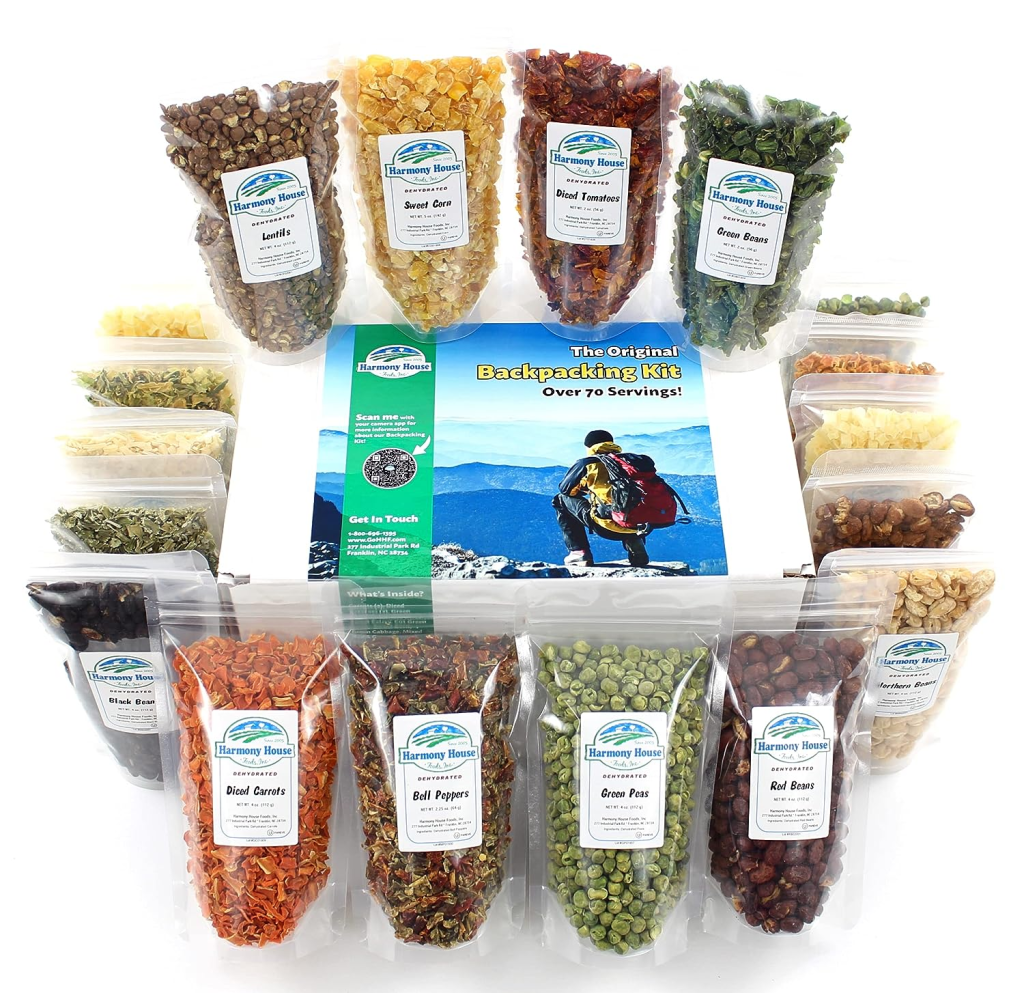
The quest for nutritious, lightweight, and long-lasting meals often leads backpackers to explore dehydrated foods. Serving as a vital source of sustenance to fuel outdoor endeavors, these foods come in various categories – ranging from fruits, vegetables, and meats to complete meals and even desserts. They present an interesting dichotomy: while dehydrated, they offer little appeal. However, once rehydrated, they provide essential proteins, carbohydrates, minerals, and vitamins, making them a worthy ally in battling hunger and maintaining energy levels during a rigorous backpacking trip. Along with their nutritional value, mastering the nuances of their preparation, proper storage, and methods to enhance preservation are equally important for those delving into the backpacking lifestyle. That is why we have crafted this dehydrated backpacking food guide for your use.
Better read up on the lightweight cookware you will need too!
Types of Dehydrated Backpacking Food
Understanding Dehydrated Backpacking Food
Among the many choices of meal options for hikers and campers, dehydrated backpacking food has gained popularity due to its nutritional value and lightweight character. The wide selection ranges from dehydrated fruits and vegetables to meats, all retaining their nutrients after the dehydration process. Fruits like bananas, apples, and strawberries, and vegetables such as bell peppers, tomatoes, and beans are readily available in the market, offering a nutritious quick snack while you’re on the move.
Protein isn’t lacking either, with dehydrated meats available, ranging from common picks like beef, turkey, and chicken to more exotic options like venison and bison. Whether consumed as is or rehydrated with a pasta or rice dish, they’re a valuable addition to your trail menu. If you prefer a full, ready-to-eat meal, the market offers dehydrated pasta dishes, soups, chilis, and even breakfast options such as scrambled eggs and oatmeal. Dehydrated desserts, from apple pie to cheesecake, are also available for those who crave a sweet finish to their meal.

Nutrition Value and Need
The Health Benefits of Dehydrated Backpacking Food
Dehydrated backpacking food isn’t just an extra light addition to your backpack; it’s also a nutritious fuel source for the physically demanding trails ahead. Ensuring a balanced diet while on adventurous excursions is essential, and this type of food provides significant amounts of essential nutrients. Carbohydrate-dense, dehydrated foods give your body the glucose it needs for immediate energy and reserves for later on. Plus, the high-quality protein found in these meals helps repair worn tissues and build up muscle during the hike.
Food storage, even dehydrated backpacking food, is critical while hiking. Learn more now.
Nutritional Value of Dehydrated Backpacking Food
The high nutritional value of dehydrated backpacking food caters to the increased dietary needs of backpackers. Proteins in these foods help maintain muscle mass, bolster the immune system, and promote cellular regeneration. Carbohydrates, meanwhile, ensure sustained energy levels during arduous hikes. The presence of key minerals like sodium, potassium, and magnesium, maintain bodily fluids and ward off dehydration. Rich in vitamins A, C, and E, the fruits and vegetables incorporated into these meals act as antioxidants, enhancing iron absorption and boosting the immune system. To meet all nutritional requirements, backpackers should incorporate a varied selection of these nutrient-dense meals into their diet.
Preparation and Consumption
Cooking Dehydrated Backpacking Food
Preparing dehydrated backpacking food is both simple and convenient, typically requiring only boiling water to revive the meal. Consequently, a portable stove and a lightweight, durable pot become indispensable tools on the trail. The pot’s lid keeps in heat and speeds up rehydration time, crucial for certain meals that may need more time to fully rehydrate. The water will absorb more fully into the food the longer it has to steep like tea. So be patient! To ensure even rehydration, stir the meal occaisionally, as this will prevent dry spots in the dehydrated meal.

Understanding Water Resources and Purification in Relation to Dehydrated Backpacking Food
When talking about dehydrated backpacking food, one cannot overlook water sourcing and purification’s significant role. Water is a crucial element in bringing the dehydrated food back to life. Therefore, it is necessary to have a reliable water filter or purifier as part of your backpacking gear. It helps ensure that any water gathered from lakes, rivers, brooks, or springs along your trail is safe for consumption. Methods for purifying water include boiling it for at least one minute or using filtration devices, tablets, or UV light. In regions where water is in short supply, plan your day well to locate water sources. This is the key to enjoying a delectable, hydrated meal instead of a disappointing dry dinner.

Looking for an adventurous backpacking trip? Check out one of these great options in Washington.
Preservation and Storage
The Science Behind the Preservation of Dehydrated Backpacking Food
The preservation of dehydrated backpacking food is primarily attributed to the act of removing the moisture that otherwise permits bacteria, yeasts, and molds to grow. These elements lead to food spoilage. Dehydrating the food prevents microbial activity from starting. This transforms the food into a safe, shelf-stable commodity for an extended duration. Certain varieties of backpacking food might undergo freeze-drying, which extracts water via sublimation, resulting in an incredibly dry product. Such food items are commonly packaged in vacuum-sealed bags to ward off moisture and oxygen’s reintroduction, which could spoil the food. Oxygen absorbers are also added by a few manufacturers into these packages to increase the food’s shelf life further.
Storage Guidelines for Dehydrated Backpacking Food
The key to maximizing the shelf life and maintaining the quality of dehydrated backpacking food is proper storage. The food should be stored in a cool, dry place away from direct sunlight and heat sources. Exposure to heat can degrade the quality of the food and reduce its shelf life. Moreover, temperature fluctuations will lead to the condensation of moisture within the package. This may rehydrate the food and encourage microbial growth.
Consider these factors when choosing storage areas that can keep your backpacking meals safe and tasty over time. Think, of dry pantries or cabinets rather than humid basements or garages. The original packaging should be kept intact until consumption. This is because it is typically designed to protect food from oxygen, moisture, and light. For optimal food safety, it’s always best to observe the manufacturer’s recommendations and “use by” dates when they’re provided.
Find the best backpack for carrying your delicious food!
Final Thoughts on Dehydrated Backpacking Food Guide
In essence, dehydrated backpacking food offers a remarkable solution to the age-old problem of carrying safe, nutritious, and tasty food outdoors. With a wide variety of choices in fruits, vegetables, meats, meals, and desserts, there is something to satisfy every palate. Navigating the intricacies of preparation and understanding the science of their preservation and storage further cultivates the backpacker’s preparedness. As you embark on your backpacking journey, embracing the practicality and convenience of dehydrated foods can greatly enhance your experience. As long as you’re armed with knowledge and a spoon, the wilderness is yours to explore.







